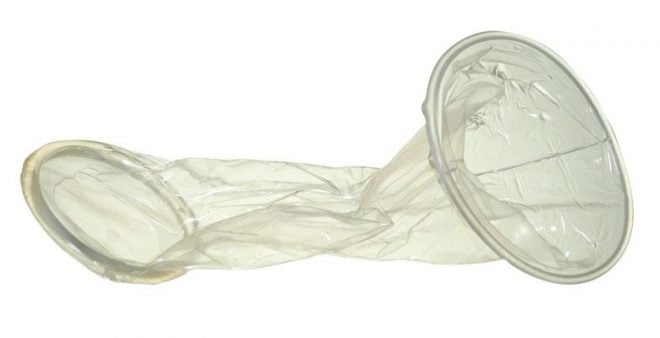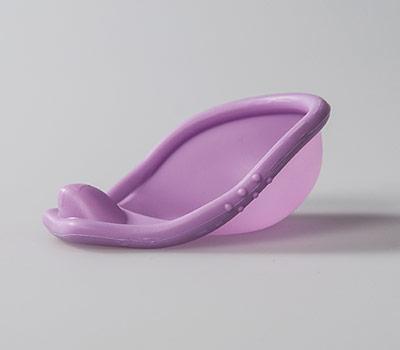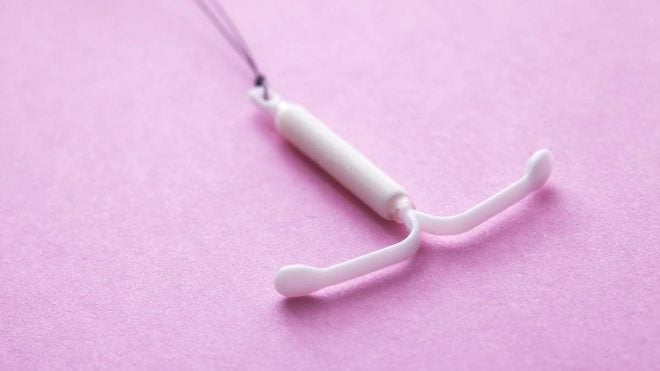A Practical Guide To Finding A Contraceptive That Works For You
Know your options, know your rights!

I’m sitting my GP’s office when she pulls out the chart: faded pastel, laminated and titled “Your Contraceptive Options”. Doc whips a pen from the cup on her desk and traces an imaginary line through the chart, explaining my options to me. As she does so, I realise it’s the first time I’ve heard all the available options spelled out — which seems incredible at age 27.
Contraceptives are generally separated into the following categories: natural methods, barrier methods, daily contraceptive methods, and the lesser-known long acting reversible contraceptive (LARC) methods. And each of these avenues comes with its own pros and cons, because every body is different.
I am a regular condom user, but the 98 percent effectiveness rate has started to niggle at my neurotic brain. (And that’s when used “correctly and consistently“, not accounting for the very real danger of condom malfunctions and the practical reality of inconsistent use.) So here I am with my GP, exploring some alternative options.
This is a medical concern. It’s an economic concern. It’s just straight-up concerning.
Contraception can often feel like an absolute minefield. Not only are there a dozen or so options, each with their own benefits and drawbacks — and each affecting our individual bodies in vastly different ways — there’s a swirl of misinformation that hovers around the issue. Then there’s the obvious: not one of the longer-term contraceptive options available in Australia can be used by men.
So it’s up to people with uteruses to choose their preferred method to control their fertility! In a country where abortion rights are still under contest in several states, this is a severely pressing and life-altering decision. It’s a medical concern; it’s an economic concern. It’s just straight-up concerning.
“People don’t necessarily have all the information they need about the options for contraception,” explains Dr Mary Stewart, the Senior Medical Officer in Research and Education at Family Planning NSW. “The pill is very much in people’s minds when it comes to contraception in Australia.”
I know that my perception of contraceptive choice has always felt limited to barrier methods — condoms, diaphragms, etc — or the boilerplate daily hormonal contraceptive pill. But, even with regard to the pill, the options can appear limitless.

“There are so many options available,” agrees Dr Stewart.
In fact, when I polled my friends in both casual and long-term relationships, a large portion of them confessed to “pulling out” or forgoing contraception during sex, because of the lack of accessible information about their vast (and often confusing) contraceptive options.
Stunning as this may seem, it’s a choice that increasing numbers of sexually active Australians (and people all over the world) are choosing to make. When I asked them why, many explained that contraceptives just seem too impractical or confusing an area to delve into.
But, since contraceptives protect our economic, medical and personal security, in order to best serve your sexual (and general) health, you just have to be clued into all your options so you can make the best decision for you.
“One of the challenges is finding the right contraception for you,” says Dr Stewart. “It can sometimes be a matter of trying to find the right fit, and that might be a different type of hormonal method of contraception, or it might be a non-hormonal method of contraception.”
However, as Mary tell us, the most important thing is to understand that “most methods of contraception tend to work really well if you use them properly” and choose what’s most practical, safe and effective for you.
Let’s run through the options:
Keep It Au Naturel

This year Monash University released a report that charted an increase in use of natural contraceptive methods in sexually active Australians from around 7 percent to 15 percent. That’s a huge increase, especially considering the popular wisdom on natural contraceptives is that it’s all ineffective BS. So… what exactly is “natural contraception”?
Natural contraceptives involve fertility tracking and/or coitus interruptus (more commonly known as the “withdrawal” or “pull out” method). As Dr Stewart explained, natural contraceptive methods require absolute diligence to carry off effectively, and trust between you and your partner.
If done absolutely correctly, the withdrawal method can be up to 96 percent effective, and the most effective method of fertility tracking can be up to 99 percent effective. But most of the time, natural contraceptives — which are difficult to manage and take a great deal of practice — can be as little as 75 percent effective. That means that up to 25 of 100 couples using natural methods could become pregnant as a result.
“Women are a little bit more wary about hormones than they may have been in the past.”
And though many doctors agree that natural contraceptives tend to be less effective than hormonal, barrier or long-acting alternatives, there’s still a place in the contraceptive world for diligent and effective natural contraceptive use. “You do have to be really committed to being very much in touch with what is happening with your natural fertility,” Dr Stewart explains. “And having a really committed partner is important as well, so you can really time most effectively how to use those methods.”
Health services advise that couples practicing the natural methods, especially withdrawal, should keep emergency contraceptive (the morning-after pill) handy just in case semen gets on or in the vagina. And couples should remember that just the smallest amount of semen (even ejaculate from pre-cum) can result in pregnancy.
Overall, while it can be a reasonably effective method of contraception (although absolutely ineffective against STIs, and so not recommended for casual encounters, or intercourse with multiple partners), it requires a great deal of attention for it to be maximally effective.
“It does sort of ring true with what we’re hearing,” Dr Stewart tells me when I ask about the Monash University study into natural contraceptive methods. “And it goes without saying that women are a little bit more wary about hormones than they may have been in the past.” But Dr Stewart stresses that “it is important they understand that there are other non-hormonal methods that are really effective.”
Put Up Some Barriers

Do you remember that class when you learned to put a condom on a banana? Me neither — and yet, the condom is still my go-to form of contraceptive.
That’s for a few very good reasons: not only are condoms cheap and easily accessible, they’re also the only method to protect yourself against infectious diseases like chlamydia, gonorrhoea and HIV. If you and your sexual partner are not exclusive, or you’re engaging in casual sex, a condom is a must.
Condoms are just one of a few barrier methods available to sexually active Australians.

Yep… that’s Drake blowing up a condom, fam.
There’s also the dental dam, a latex or polyeurethane sheet placed between the mouth and the vagina when performing oral sex (this is one of the few effective methods of STI protection for queer women).
And there’s the little-used female condom: a polyeurethane device, similar to a male condom, that’s inserted into the vagina before sex. It has flexible rings at each end to keep it in place, and can be used to protect against conception and STIs.

Additionally, there’s the retro diaphragm, one of the oldest (but still most highly effective) methods of contraception around. These days, the most effective diaphragm is a single-size contraceptive barrier device called the Caya® diaphragm, which is made from silicone and designed to have a contoured oval shape suitable for most women, unlike the traditional dome-shaped diaphragm.
The device is inserted to cover the cervix before intercourse, and left in for six hours after — it is not made to be kept inside long-term but can be put in hours before sex.

The Caya diaphragm is the first redesign of this contraceptive method in 50 years.
The trick with barrier contraceptive methods is correct and consistent use. As Dr Stewart explains, “Some methods are less effective than others with typical use.” Barrier methods are only effective if they are used as instructed — and consistently — during sexual encounters.
Still, these methods can be very effective, especially for short-term use, as they are a barrier to contraception and STIs.
A Pill A Day…

The daily hormonal contraceptive pill, or just “the pill”, is the most widely known (and widely used) method of contraception in Australia. There are myriad brands of hormonal contraceptive pill, but of the many brands there are just two distinct types: the combined hormonal pill, and progestrogen-only pill (POP) or “mini-pill”.
The daily hormonal contraceptive pill remains the most popular choice of fertility control for sexually active Australians, along with the condom. “The latest data for women 16-49 who are using a method of contraception is that it’s 33 percent using the pill, and 30 percent using condoms. Obviously some are using both,” says Dr Stewart. “But the pill is very widely used.”
Still, many women have discovered that a daily dose of hormones, while it can have many benefits, can also be a hugely impractical and life-altering choice of contraceptive.

“Some people are concerned about using hormones,” Dr Stewart explained. “That may be because they’re concerned about the effect on their libido, or effect on mood. And that’s something that’s really hard to study properly, but we know that with some people it can have an impact.”
Additionally, choosing the pill means committing to taking it on the reg. “If you’re relying on the pill,” Dr Stewart says, “obviously you have to remember to take it every day.” Inconsistent use can often be where these daily contraceptive methods fail, so diligence with the hormonal contraceptive pill is key.
It’s important, if choosing the daily contraceptive pill, that you consult with your doctor on the best choice for you. Often you may have to try one, two or even more pills to get the right brand for you. But, of course, that consultation can be worth it, if a reliable daily contraceptive method is the result.
The Longer The Better

The long acting reversible contraceptive (LARC) methods are at once the least used and most broadly effective contraceptive methods in Australia. Dr Stewart tells me, “We’ve got really low usage of what we call the long acting reversible contraceptive, which is the most effective method.” LARC includes the intrauterine devices (IUDs) and the contraceptive implant (ImplanonNXT).
The LARC methods come with a heap of benefits: while initially more expensive to implant, the LARCs tend to last from anywhere between three-eight years so they’re exponentially cheaper in the long-term. They also require little to no upkeep: once inserted, they remain in place and working until you’re due for a new one.
This, Dr Stewart explains, is the chief benefit of the LARC methods. “Something like an IUD or an implant,” she says, “the reason that it’s so effective is that it doesn’t depend on the user doing anything once it’s actually been inserted or implanted. So, you know, you don’t have to remember to do something every day.”
Additionally, the IUD comes in a hormonal or non-hormonal version (the non-hormonal being the copper IUD), so “for women who are looking for something that’s non-hormonal but really effective, and very immediately reversible, then the copper IUD is actually a really good option for them,” says Dr Stewart. The IUDs are devices inserted into the uterus, which act in the long-term to prevent unwanted pregnancy. They are inserted by a medical practitioner for a one-off fee, and they’re designed to remain in place for five-ten years.

Like all contraceptives, they do have their up- and downsides. “One of the side-effects unfortunately for the copper IUD is it does tend to make periods a little bit heavier and last longer,” Dr Stewart explains. “And then you’ve got the other IUD, which is the hormonal IUD, which actually makes periods very light and really improves menstrual symptoms significantly.”
Additionally, there’s the Implanon contraceptive implant, which is a hormonal contraceptive rod injected into the user’s arm and kept in place for up to three years before it needs to be removed or replaced. Implanon can also have some adverse side-effects, like troublesome bleeding for around one in five people. But, as Dr Stewart attests, “any medication always has its benefits but also has its risks, and we just have to be aware of those and weigh up that benefit-risk ratio for ourselves.”
So, when approaching the LARC methods, it’s best (as with all contraceptive choices) to approach your doctor for an assessment, to choose which method is right for you.
And Dr Stewart is a huge advocate of the LARC, which she says has seen “a slow increase” in uptake as Australians have become more aware of them. And, if a LARC is right for you, you’ll see the benefits of over 99.9 percent effectiveness. Citing a study from the US (the Choice Study), Dr Stewart says: “In that particular study they found that women who chose the short-acting method had a 20 times higher risk of an unintended pregnancy in the follow-up period, compared to those who chose the longer-acting method”.
So, What’s The Verdict?
There are so many contraceptive choices and each one comes with its own benefits and risk factors. But choosing a contraceptive that’s right for you can be just as simple as a trip to your local GP or sexual/reproductive health clinic. As long as your doctor is assessing your body and your needs appropriately, and weighing up what’s best for you, theoretically every person should be able to find a practical and effective form of contraception to help control their fertility.
“I think it’s really important to get accurate information, and to talk to healthcare providers about the methods of contraception that they’re wanting to use,” Dr Stewart tells me. “With the right patient, all methods can be very safe. So it’s really important that doctors do a proper assessment of women to ascertain whether a method is safe or not.”
So take this guide along to your GP, or to a family planning or sexual health clinic, and get ready to explore your options. And remember, reproductive health is a basic human right. We have the right to access all the available information about our contraceptive options, and the right to choose the method that’s right for us. Don’t let misinformation or barriers to access stop you from getting the reproductive support that is your right.
—
If you would like more information about your contraceptive options, visit the Family Planning NSW website, which has a wealth of information to assist in making the contraceptive choice that’s right for you.
You can also access FPNSW’s information by booking an appointment at one of their NSW clinics, or via their Talkline: 1300 658 886. There are sexual health and family planning clinics in every state in Australia.
—
Matilda Dixon-Smith is Junkee’s Staff Writer. She tweets at @mdixonsmith.